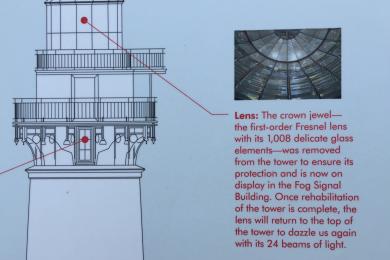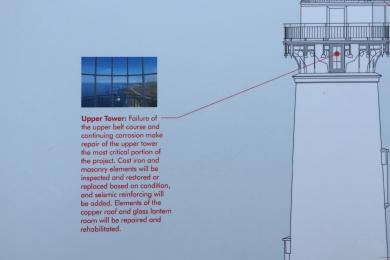Background
In 1980 the Department of Parks and Recreation (DPR) leased Pigeon Point Light Station from the U.S. Coast Guard and operated it as a park. In December 2000 a piece of the cast iron band that gave the tower its structural integrity fell to the ground. This resulted in the tower being closed to the public early in 2001. It has remained closed ever since.
The transfer of the property to the State of California was a protracted process that started in 2005. When the DPR received title to Pigeon Point Light Station in 2011, the California State Park Foundation had signed up to the task of fundraising for the restoration project.
The Project Starts
The first project the Foundation funded was removing the Fresnel lens from the lantern room and reassembling it in the Fog Signal Building for preservation and interpretation. More people will see the lens in its current location, and it helps us to tell the story of the restoration process. The intention is to return the lens to the lantern room when the tower is structurally stable.
The next step was creating the Historic Structures Report; a vital element to understanding the building and the changes that had been made over time. The plan is to restore the building to a historical point in time.
The Foundation continued its work with stabilization of the cast iron band, sealing bricks and windows, and a Rehabilitation plan for the restoration process. It identified several areas that need work and came up with a multi-phased plan. Interpretive signs that describe the restoration project were installed around the site, and a donor-recognition board was placed inside the Fog Signal Building. The Upper Tower is the most critical part of the project. As its sign says, “Cast iron and masonry elements will be inspected and restored or replaced based on condition, and seismic reinforcing will be added.”
Next, the Foundation funded the preparation of the architectural drawings that will be used to restore the structure. This was the last step needed to get permits and start the real fundraising push.
Disappointing News
By late 2016, the fundraising campaign hadn’t really kicked off. Parks’ staff, park docents and CSPA board members were all hoping that something would start soon. But the Foundation gave notice in November 2016 that their organization was changing direction and could not continue fundraising for large projects, including Pigeon Point Light Station’s restoration.
The Future
DPR and CSPA are as committed as ever to moving the restoration project forward. As we reported in July, the General Plan was approved by DPR, and the emphasis running through the plan is that the tower will be restored and re-opened for public viewing. State Parks is currently assessing how to raise the necessary funds, and move the project forward. They and we recognize that the 8-figure price tag for the tower’s restoration is beyond the ability of CSPA’s annual 6-figure budget to handle alone.
In the interim, CSPA will accept donations specifically targeted for the restoration of the tower and hold them until either a fundraising partner has been identified or funds can be transferred to State Parks for near-term work to be done. If you wish to make such a donation, please be sure to designate it for “Tower Restoration” on your check when mailing your donation, by an entry under Campaign when donating online through CSPA’s website, or by sending CSPA an email at the time of your donation. Any donations for Pigeon Point not specifically marked for Tower Restoration will be used to support CSPA’s continuing, multi-phased efforts to restore other historic buildings at Pigeon Point, including the Fog Signal Building.


